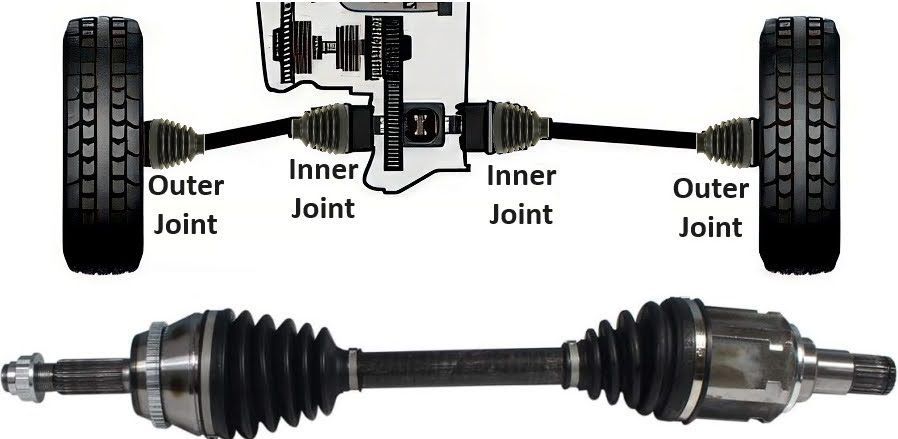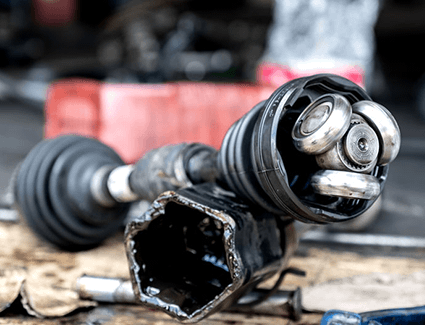CV Joints: The Most Abused Part You Never Think About
NaTasha Brand • June 9, 2025
The Heroes (and Victims) of Your Drivetrain

Your car’s CV (constant velocity) joints are like the hardworking stagehands of a theater production—no one notices them until something goes horribly wrong. These crucial components transfer power from your transmission to your wheels while allowing for smooth steering and suspension movement. Yet, despite their importance, CV joints are often ignored until they fail catastrophically.
At Ric Henry’s Auto Service, we’ve seen too many drivers wait until their CV joints are clicking, clunking, or even spewing grease before addressing the problem. In this post, we’ll break down:
✔ What CV joints do (and why they matter)
✔ The warning signs of failure
✔ Why DIY fixes often make things worse
✔ How proper maintenance extends their lifespan
What Do CV Joints Actually Do?
CV joints are the flexible pivot points between your axles and wheels. They allow:
✅ Power transfer from the engine to the wheels
✅ Smooth steering while maintaining torque
✅ Up-and-down suspension movement without binding
There are two types:
Outer CV joints (connect to the wheels)
Inner CV joints (connect to the transmission/differential)
Both are packed with grease and sealed in a rubber boot—which is usually the first thing to fail.
Symptoms of a Failing CV Joint
1. The Telltale Clicking on Turns
A loud, rhythmic clicking when turning (especially at low speeds)
Means the joint’s bearings are worn out
2. Grease Everywhere (Boot Failure)
A torn boot flings grease onto your wheel, brakes, or undercarriage
Once the grease leaks out, dirt gets in, and the joint fails quickly
3. Vibration Under Acceleration
Worn CV joints cause shuddering or shaking when you press the gas
Often mistaken for wheel balance issues
4. Clunking When Shifting Gears
A loud "clunk" when switching from Drive to Reverse (or vice versa)
Indicates excessive play in the joint
5. Steering Wheel Wobble
If the CV joint is severely worn, it can cause steering instability
Why CV Joints Fail (And How to Make Them Last)
Common Causes of Failure
Torn boots (letting grease out and dirt in)
Lack of lubrication (dry joints wear out fast)
Aggressive driving (hard launches, off-roading)
Age/mileage (most last 80,000–150,000 miles)
Maintenance Tips
✔ Inspect boots regularly (look for cracks/leaks)
✔ Replace torn boots immediately (before the joint fails)
✔ Avoid harsh acceleration (especially on lifted trucks)
Why You Should Leave CV Joint Repairs to the Pros
1. Specialized Tools & Presses Are Required
Removing/installing CV axles often requires hydraulic presses
DIY attempts can damage the axle or transmission
2. Proper Greasing & Sealing Matters
Cheap aftermarket boots often fail prematurely
Incorrect grease leads to early wear
3. Alignment Must Be Checked Afterward
Improperly installed axles can cause vibration or premature wear
At Ric Henry’s Auto Service, we:
🔧 Use OEM-quality CV axles & boots
🔧 Press-fit joints properly (no cheap clamps)
🔧 Check alignment post-repair
🔧 Back our work with a 3-year/36,000-mile warranty
Don’t Wait Until Your CV Joint Sounds Like a Maraca
A failing CV joint won’t heal itself—it’ll just leave you stranded at the worst possible moment. If you hear clicking, see grease leaks, or feel vibrations, bring your car to Ric Henry’s Auto Service before it turns into a much more expensive problem.


Here in San Angelo, our vehicles face it all: the dust of West Texas backroads, the blazing heat on Chadbourne Street, and the occasional surprise chill. Through it all, we trust our engines to get us to the Concho River or out to the lakes without a second thought. But deep within that trusted powerplant, a critical component might be slowly elongating, turning into a literal ticking time bomb. Let's talk about timing chain stretch, the silent engine killer. The Conductor of the Internal Combustion Orchestra First, what is this thing? Your timing chain (or belt, in some cars) is the mini maestro of your engine. It’s the critical link that synchronizes the rotation of the crankshaft (the part that goes up and down with the pistons) and the camshaft (the part that opens and closes the valves). This precise coordination ensures that fuel and air enter, combust, and exit at the exact right millisecond. When the timing is perfect, your engine purrs with efficiency and power. When it’s off, even slightly, the performance symphony descends into cacophony. The Slow Stretch: Causes & Symptoms Unlike a snapped timing belt which often causes catastrophic failure, a stretching chain is a master of deception. It doesn’t happen overnight. The primary culprits are: • Mileage & Wear : Simply put, everything has a service life. Over thousands of miles and millions of cycles, the chain's pins and bushings wear down. • Poor Lubrication : This is the big one. Old, sludgy oil or infrequent oil changes are public enemy #1 for your timing chain. The chain relies on a constant bath of clean engine oil for lubrication and cooling. In our Texas heat, oil can break down faster. Skipping an oil change isn't just about the oil itself; it's starving this vital component. • Faulty Tensioners : The chain tensioner’s job is to take up slack. When it fails, it allows excess movement, accelerating wear and stretch. So, how do you know your maestro is losing the beat? Listen and feel: • The Tell-Tale Rattle : A persistent rattling or clattering noise from the front of the engine, especially at startup or at low RPMs, is the classic harbinger. • Check Engine Light : The engine’s computer is precise. As timing drifts, it will often trigger codes related to cam/crank correlation. • Performance Woes : Sluggish acceleration, poor fuel economy, rough idling, or even misfires. The engine is literally out of sync. Why This Isn't a DIY Project for Your San Angelo Garage We get it. The DIY spirit is strong. But timing chain replacement is a deep-engine surgery. It requires: • Specialized tools (cam lock bars, crank holders) to lock the engine in time. • Meticulous disassembly, often involving the front of the engine. • Absolute precision in reassembly. Being one tooth off can lead to bent valves, damaged pistons, and an engine that won’t run, turning a repair into a replacement. This is a job where "close" isn't good enough. It requires the expertise and equipment of a seasoned professional. Your San Angelo Solution: Ric Henry’s Auto Service When the rattle starts and your engine’s timing is in question, you need a shop you can trust with the heart of your vehicle. At Ric Henry’s Auto Service, we treat timing chain jobs with the seriousness they deserve. Our experienced technicians are equipped with the same advanced tools and diagnostic equipment the dealerships use, ensuring a precise and reliable repair. We don’t just stop at the repair. We offer the comprehensive maintenance that prevents these issues, like routine oil changes with quality fluids tailored to our climate. And because we believe in our work and your peace of mind, every service we provide is backed by a strong 3-Year/36,000-Mile Warranty. Don’t let a stretched chain lead to a snapped budget. If you’re hearing unusual sounds from under the hood, trust the pros at Ric Henry’s to diagnose it accurately and fix it right the first time. Think of it this way: a timing chain replacement is far cheaper than a new engine. Let’s keep your engine's timing as perfect as a San Angelo sunset.




Share On: